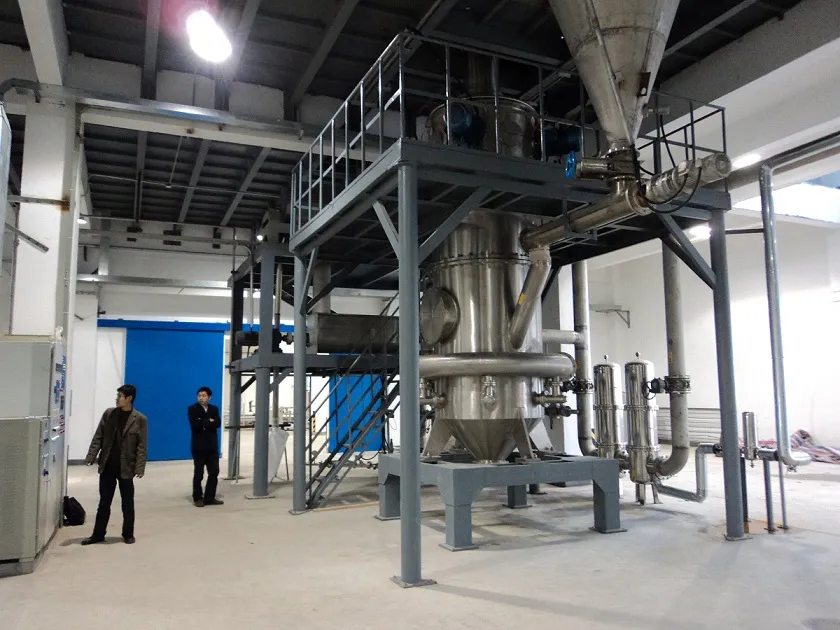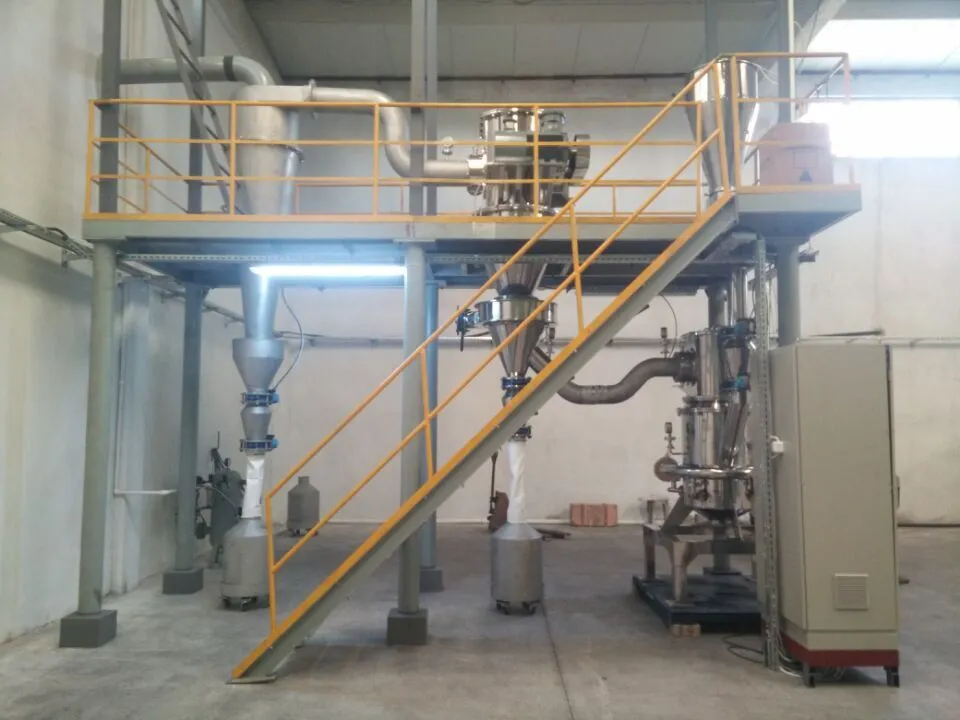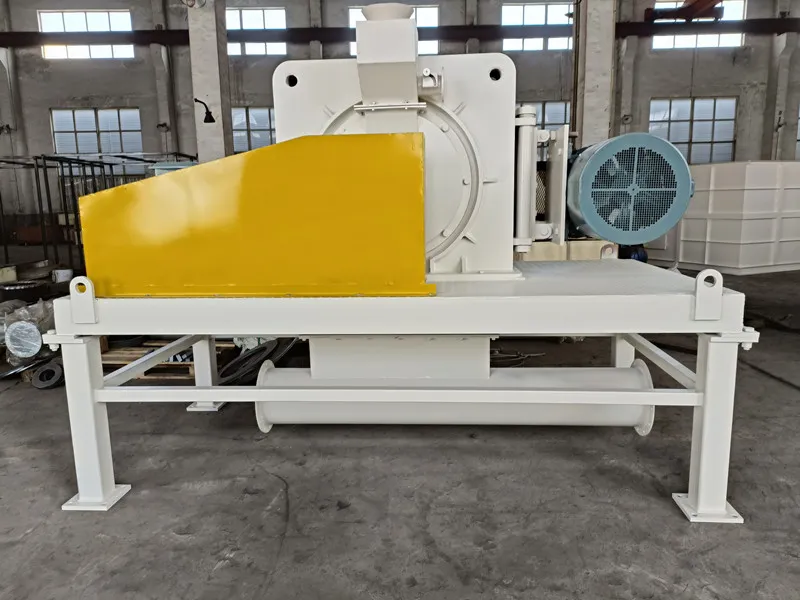Honeycomb grinding - drying, depolymerization, modification, modification
Honeycomb mill is a mechanical grinding machine that advocates the practical process of first depolymerization and then drying, and synchronous surface treatment. It is specifically designed for the production of ultrafine powders with strict requirements for particle size distribution.
- Honeycomb mill is a mechanical grinding machine that advocates the practical process of first depolymerization and then drying, and synchronous surface treatment. It is specifically designed for the production of ultrafine powders with strict requirements for particle size distribution.
- Simultaneously achieve grinding, drying, sorting, and surface chemical treatment with powder, while drying and depolymerizing wet grinding filter cake and slurry.
- The minimum processing capacity is 0.05 tons/hour, the maximum is 15 tons/hour, and the maximum water evaporation capacity is 3 tons/hour.
- According to the diversity of materials, different materials can be used inside the equipment, which have the advantages of retaining the color and purity of the materials. The coating rate can reach 99.2%, and the activation rate can reach 99.8%.
The working principle of honeycomb mill
The main component is a vertically installed multi-stage disassembly wheel, each stage of disassembly wheel consisting of two supporting discs mounted on the main shaft and clamping 200 blades. According to specific load requirements, a honeycomb mill can install 10 disassembly wheel components and a maximum of 2000 disassembly blades. The blades rotate at a speed of 110 meters per second, and the grinding groove of 6 millimeters is a unique reinforcing rib type fixed lining. 160 turbulent “honeycombs” are formed between the blades and the lining, and the pressure, shear force, and friction between them can quickly grind the material into ultrafine powder.

Characteristics of Honeycomb Grinding
All honeycomb mills are designed with modularity. This allows for the adoption of optimal designs for different environments for each device, while maintaining the basic principles and identical components unchanged.
Optimize equipment performance by changing the number of rotor layers and blades. The integrated installation of the sorting machine does not affect the structure of the main grinding chamber.
This modular structural design makes maintenance and replacement of vulnerable parts very easy.
The material of rotor blades can be hardened steel, stainless steel, or tungsten carbide steel.
The grinding groove material is made of steel, high chromium iron, stainless steel, or high alumina ceramics.
Honeycomb grinding characteristics
The rotor and lining strip can be removed as a whole from the mill.
The rotor and lining can be repaired outside the mill, reducing downtime.
The rotating components use drive pins instead of keys, making installation easier.
There are no blades or lining bolts inside the grinder.
The rotating components underwent dynamic balancing inspection before installation to ensure the service life of the bearings.
During normal operation, there is no need to make any adjustments to the honeycomb mill.
Honeycomb grinding and drying function
When the process gas is heated by the hot air generator, the honeycomb mill will become an efficient dryer. The maximum temperature that the honeycomb mill can accept is 450 ℃. By controlling the outlet temperature, the dryness of the product can be controlled, with a typical outlet temperature of 85 ℃.
The main function of drying is to break the hydrogen bonds, adsorption wet bridges, and other chemical bonding interactions on the surface of nanoparticles, prevent mutual adhesion and aggregation between particles, and lay the foundation for subsequent depolymerization and crushing.
The moisture content of the deeply dried powder is reduced to 5 ‱, while the modifier is gasified into single particles to make the material more evenly wrapped.
Honeycomb grinding depolymerization function
The honeycomb mill runs at a linear speed of 110 meters per second, driving a strong air flow that allows the agglomerated powder particles to stay inside the stator with a special groove design. The wind pressure and speed form strong vortices, generating shear, friction, and centrifugal forces that quickly rub the material into single particles and return them to their original particle size or natural crystal size. The material is brought out of the honeycomb mill disintegration chamber in a boiling state by the rotor.
Honeycomb grinding and drying function
Functional materials often require surface treatment to alter their functionality. The vast majority of surfactants can be injected into the grinding zone of the mill after being measured in a certain proportion. Under normal conditions, two or more coating media can be applied simultaneously.

Materials and parameter technology for honeycomb grinding treatment
| Mineral | Chemical | Food |
|---|---|---|
| Clay | Alginate | Animal protein |
| Kaolin (natural and calcined) | Hydrotalcite | Casein |
| Limestone, marble, calcite | Iron oxide | Cocoa powder |
| Aluminum hydroxide | Magnesium hydroxide | Pea |
| PCC & GCe | Methyl cellulose | Potato protein |
| Phosphate | pigment | sugar |
| Precipitated silica | Silica gel | Wheat flour |
| Talc | Stearic acid | Wheat bran |
| Titanium dioxide | Zeolite | Wheat starch |
| MODEL | MRD-1 | MRD-2 | MRD-3 | MRD-4 | MRD-5 | MRD-6 |
|---|---|---|---|---|---|---|
| Grinding Motor Power(kW) | 45 | 90 | 160 | 200 | 315 | 450 |
| Classifying Motor Power (kW) | 5.5 | 7.5 | 15 | 22 | 37 | 55 |
| Blade(layer) | 3-6 | 4-7 | 5-8 | 5-8 | 5-8 | 6-10 |
| Blade speed(m/s) | 120 | 120 | 120 | 120 | 120 | 120 |
| Air volume(m³/h) | 4,500 | 7,000 | 12,000 | 16,000 | 24000 | 36,000 |
Project Cases
Production Line of Lithium Iron Phosphate for an Electric Vehicle Company in Huizhou
A New Material Company in Zhejiang: Metal powder grinding equipment
Silica soil drying and dispersing modification production line of a mineral products company in Jiangsu
Air Classifying production line of carbon microspheres in a chemical plant in Hubei
A ball milling and modification production line in a calcium carbonate factory in Iran
Milk powder grinding production line of a company in Menggu
Latest News
GET IN TOUCH
Our experts will contact you within 6 hours to discuss your needs for machine and processes.
Factory Address:
NO. 369, Road S209, Huanxiu , Qingdao City, China






